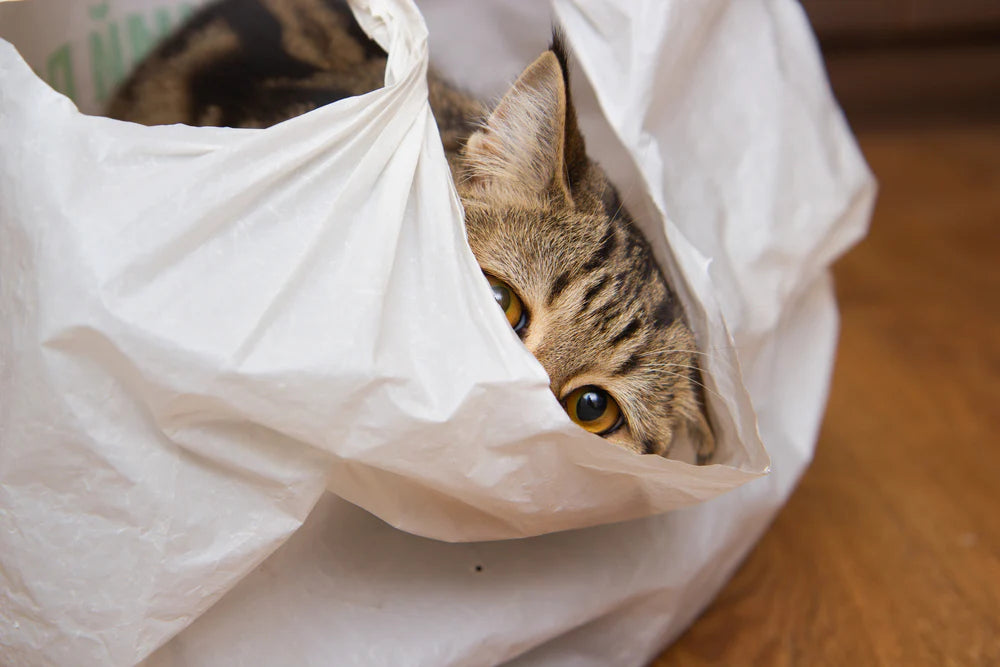Why Do Cats Lick Plastic?

Have you ever caught your cat licking plastic bags or chewing on plastic items around the house? This peculiar behavior leaves many pet owners puzzled and concerned. While other pets are not our feline friends, they have their own odd habits, including an affinity for plastic grocery bags and other plastic objects.
This blog explores why cats lick plastic bags and the potential risks associated with cats eating plastic. We will also explore how to prevent some helpful tips to prevent cats from chewing plastic, such as investing in high-quality cat toys.
Possible Reasons Why Cats Lick Plastic Bags

Cats licking plastic is a behavior that has puzzled many pet owners. There are several reasons why cats may do this:
- Attraction to the Smell or Taste: Some plastics can carry the scent or residue of food, which may attract cats. Additionally, certain plastics may release appealing odors to a cat's strong sense of smell.
- Texture: The texture of plastic may be appealing to some cats. Licking a smooth, cool surface can be a novel sensation for them.
- Pica: Pica is a condition where animals (or people) feel eating non food items. A cat consistently licking or eating plastic could be a sign of pica, which could stem from dietary deficiencies or other health issues.
- Compulsive Behavior: Some cats develop compulsive behaviors, including licking non-food materials. This can be due to stress, anxiety, or other psychological factors.
- Boredom or Curiosity: Cats are naturally curious creatures and may lick plastic simply because they're exploring their environment. Boredom can also lead them to seek out new textures or activities.
Potential Dangers
Cats licking plastic bags might seem harmless and quirky, but this activity has several potential dangers. Here are the main risks involved:
- Chemical Ingestion: Plastics treated with chemicals can be dangerous to ingest. These chemicals might not harm the cat through mere contact, but licking or chewing can lead to ingestion of small amounts.
- Choking Hazard: Small pieces from a plastic bag can break off and become lodged in the cat's throat, posing a significant choking hazard. Even if the cat doesn't swallow the plastic, chewing on it can create sharp edges that injure the mouth or throat.
- Intestinal Blockage: If cats eat plastic shopping bags, it may lead to intestinal blockages. Symptoms include vomiting, constipation, lethargy, and loss of appetite.
- Bacterial Contamination: Plastics, especially those containing food or exposed to the environment, can harbor bacteria. When a cat licks these surfaces, it risks ingesting harmful bacteria, which could lead to infections or gastrointestinal upset.
- Behavioral Issues: Obsessive licking of plastic bags may indicate underlying behavioral or nutritional issues. For instance, pica—the compulsion to eat non-food items—can sometimes drive cats to lick or chew on plastic. This could signal nutritional deficiencies or psychological stress.
Prevent Your Cat from Licking Plastic Bags

Preventing your feline friend from licking plastic bags involves understanding the unique cat behavior that attracts cats to these items. Here are strategies to divert their attention and ensure their safety, incorporating the mentioned keywords.
Understand the Appeal
Plastic bags can mimic certain aspects of a cat's natural environment. Their noise can remind cats of the sound of small rodents or birds, while the smooth texture might appeal to their sense of touch. Some theories suggest that certain breeds are more prone to this behavior due to their high need for physical and mental stimulation.
Provide Safe Alternatives
To satisfy your cat's curiosity and need for physical stimulation without the dangers of playing with plastic, offer a variety of safe alternatives. Catnip toys, for example, can provide both physical and mental stimulation, encouraging interactive playtime that safely engages their hunting instincts.
Engage in Interactive Playtime
Dedicate time each day for interactive playtime with your cat. Use toys that mimic the hunting experience, such as feather wands or laser pointers. This prevents boredom and satisfies your cat's instinctual needs, reducing their interest in non-toy items like plastic bags.
Remove Temptation
To reduce the risk, keep plastic bags out of reach. Store them in cabinets or closets, and consider using reusable shopping bags instead. Removing the source of fascination can greatly reduce the risk of your cat engaging in this potentially harmful behavior.
Explore Physical and Mental Stimulation Alternatives
Beyond toys, consider other forms of enrichment that offer physical and mental stimulation. Puzzle feeders, for instance, can keep your cat engaged and focused on something other than plastic bags. Creating a stimulating environment with various perches and hideaways can also satisfy their exploratory nature.
Understand Your Cat's Needs
Recognizing that certain breeds require more stimulation can help you tailor your approach. If your cat seems particularly drawn to plastic bags, consider whether their environment offers enough stimulation. Increasing playtime or introducing new forms of enrichment can make all the difference.
Educate on Safety
For cat parents, it's crucial to understand the dangers associated with playing with plastic bags, including suffocation and gastrointestinal blockages. Educating yourself on these risks will motivate you to find safer alternatives that satisfy your cat's needs without compromising their health.
Choose Safer Alternatives: How to Redirect Your Cat's Plastic Obsession
Cats' fascination with licking plastic, from plastic bags to shopping bags, stems from various factors, including the crinkly sound that mimics natural prey, the cool surface, and the residues of animal fat or food odors that cling to these items. This behavior, while seemingly harmless, can lead to risks like ingesting plastic, which may cause intestinal blockages and require an emergency vet visit. For cat parents concerned about their feline friends' penchant for plastic, there's a safer route.
Previous article

Next article

Related posts
View all-

How to Keep Your Pet Calm During Thanksgiving
Thanksgiving is a time for family, friends, and food, but for our pets, the holiday can be overwhelming. The sudden change in routine, unfamiliar faces and scents, and increased noise can trigger significant stress. Understanding why your pet might feel anxious is the first step toward creating a peaceful holiday experience for everyone, including your furry family members. This guide offers calming tips for pets and practical solutions to ensure your dog or cat feels safe and secure during the festivities.
Read Article -

Top Travel Essentials for Pets This Holiday Season
Holiday travel often means bringing the whole family along, and for many of us, that includes our furry companions. Preparing for holiday pet travel is about more than just packing a bag; it's about ensuring your pet's safety, comfort, and happiness from the moment you leave home until you return. A little planning helps reduce stress for both you and your pet, making the journey a positive experience for everyone involved.
Read Article -

Best Leashes and Collars for Daily Walks: A Pet Parent’s Guide
A daily walk with your dog isn't just a chore—it's a chance to bond, explore, and stay active together. The right leash and collar can make every walk safer and more enjoyable for both of you. With numerous styles and materials available, it's essential to find gear that suits your dog's needs and your lifestyle.
Read Article



